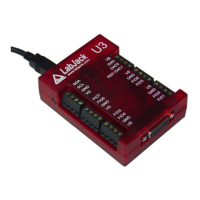3. Operation
3.1 Command/Response
Eve th mode, meaning that all
com u
the
For eve figuration, the low-level Feedback function is the primary function
use a Windows UD driver uses the
Fee a
stre
number of analog inputs requested, and is not noticeably affected
by the number of digital I/O, DAC, timer, and counter operations.
These times were measured using the example program “allio.c” (VC6_LJUD). The program
executes a loop 1000 times and divides the total time by 1000, and thus include everything
(Windows latency, UD driver overhead, communication time, U3 processing time, etc.).
Table 3-2. Typical Feedback Function Execution Times (QuickSample=1, LongSettling=0)
Table 3-3. Typical Feedback Function Execution Times (QuickSample=0, LongSettling=1)
ry ing besides streaming is done in command/response
m nication is initiated by a command from the ho
st which is followed by a response from
U3.
rything besides pin con
d, s it writes and reads virtually all I/O on the U3. The
db ck function under-the-hood to handle most requests besides configuration and
aming.
The following tables show typical measured execution times for command/response mode. The
time varies primarily with the
USB high-high USB other
# AIN
[milliseconds] [milliseconds]
0
0.6 4.0 <- Write/Read all DIO, DACs, Timers & Counters
1
0.8 4.0
4
2.2 4.0
8
4.1 5.2
16
8.2 12.4
Table 3-1. Typical Feedback Function Execution Times (QuickSample=0, LongSettling=0)
USB high-high USB other
# AIN
[milliseconds] [milliseconds]
0
0.6 4.0 <- Write/Read all DIO, DACs, Timers & Counters
1
0.6 4.0
4
0.9 4.0
8
1.5 4.0
16
3.0 8.0
USB high-high USB other
# AIN
[milliseconds] [milliseconds]
0
0.6 4.0 <- Write/Read all DIO, DACs, Timers & Counters
1
4.2 5.2
4
16 17
8
32 33
16
63 65
40

